Research on Measuring Thermal Conductivity of Quartz and Sapphire Glass Using Rear-Side Photothermal Deflection Method
Abstract
1. Introduction
2. Background Theory and Methods
2.1. Rear-Side Photothermal Deflection Method
2.2. Temperature Distribution and Phase Delay Analysis
2.3. Numerical Verification
2.4. Algorithm for Determining Thermal Conductivity
3. Experimental Investigation
3.1. Specimens for Experiment
3.2. Experimental Apparatus
4. Results
5. Conclusions
- By applying the phase delay derived through the numerical analysis of quartz and the phase delay measured through the optical alignment to the thermal conductivity determination algorithm, the absolute error and the relative error of the thermal conductivity were derived to be 0.2 W/m-K and 5%, respectively.
- For sapphire glass, which is an orthogonal anisotropic material, valid thermal conductivity for crystal orientations of was derived and confirmed from the theoretical value. The sapphire glass used for the measurement is a plane having k11, k22, and k33, respectively known to be 36.1 W/m-K, 27.1 W/m-K, and 36.1 W/m-K.
- As a result of determining the thermal conductivity by applying the phase delay derived through the experiment with respect to each crystal orientation of sapphire glass and the phase delay measured through the numerical analysis of the thermal conductivity determination algorithm, the maximum absolute error and relative error were derived to be 0.55 W/m-K and 1.5%, respectively.
- The limitation of anisotropic materials is that they must be measured in a situation where the main crystal orientation can be known. This limitation may be overcome in the future by experimentally developing a mechanism that can determine this information.
Author Contributions
Funding
Institutional Review Board Statement
Informed Consent Statement
Conflicts of Interest
References
- Takatori, H.; Hiraiwa, M.; Yano, H.; Iwata, H. Large-scale projection-based immersive display: The design and implementation of largespace. In Proceedings of the 2019 IEEE Conference on Virtual Reality and 3D User Interfaces (VR), Osaka, Japan, 23–27 March 2019; pp. 557–565. [Google Scholar]
- Kwon, J.; Suh, Y.D.; Lee, J.; Lee, P.; Han, S.; Hong, S.; Yeo, J.; Lee, H.; Ko, S.H. Recent progress in silver nanowire based flexible/wearable optoelectronics. J. Mater. Chem. C 2018, 6, 7445–7461. [Google Scholar] [CrossRef]
- Krupka, J.; Geyer, R.G.; Kuhn, M.; Hinken, J.H. Dielectric properties of single crystals of Al/sub 2/O/sub 3/, LaAlO/sub 3/, NdGaO/sub 3/, SrTiO/sub 3/, and MgO at cryogenic temperatures. IEEE Trans. Microw. Theory Tech. 1994, 42, 1886–1890. [Google Scholar] [CrossRef]
- Zhao, D.; Qian, X.; Gu, X.; Jajja, S.A.; Yang, R. Measurement techniques for thermal conductivity and interfacial thermal conductance of bulk and thin film materials. J. Electron. Packag. 2016, 138, 040802. [Google Scholar] [CrossRef]
- Powell, R.; Taylor, R. Multi-Property Apparatus and Procedure for High Temperature Determinations; Purdue University: Lafayette, IN, USA, 1970. [Google Scholar]
- Taylor, R.; Kimbrough, W.; Powell, R. Thermophysical properties of tantalum, tungsten, and tantalum-10 wt. per cent tungsten at high temperatures. J. Less Common Met. 1971, 24, 369–382. [Google Scholar] [CrossRef]
- Cahill, D.G.; Katiyar, M.; Abelson, J.R. Thermal conductivity ofa-Si:H thin films. Phys. Rev. B 1994, 50, 6077–6081. [Google Scholar] [CrossRef]
- Cezairliyan, A. Design and operational characteristics of a high-speed (millisecond) system for the measurement of thermophysical properties at high temperatures. J. Res. Natl. Bur. Stand. Sect. C: Eng. Instrum. 1971, 75, 7. [Google Scholar] [CrossRef]
- Cezairliyan, A.; Miiller, A.P. Specific heat capacity and electrical resistivity of a carbon-carbon composite in the range 1500–3000 K by a pulse heating method. Int. J. Thermophys. 1980, 1, 317–326. [Google Scholar] [CrossRef]
- Cezairliyan, A.; Morse, M.; Beckett, C. Measurement of melting point and electrical resistivity (above 2,840 deg K) of molybdenum by a pulse heating method. Revue Internationale des Hautes Températures et des Refractaires 1970, 7, 382–388. [Google Scholar]
- Sell, J. Photothermal Investigations of Solids and Fluids; Elsevier: Amsterdam, The Netherlands, 2012. [Google Scholar]
- Taylor, R. Determination of thermophysical properties by direct electric heating. High. Temp. High. Press. 1981, 13, 9–22. [Google Scholar]
- Arai, T.; Baba, T.; Ono, A. Thermographic investigation of laser flash diffusivity measurement. High. Temp. High. Press. 1987, 19, 269–273. [Google Scholar]
- Deem, H.W.; Wood, W.D. Flash Thermal-Diffusivity Measurements Using a Laser. Rev. Sci. Instrum. 1962, 33, 1107. [Google Scholar] [CrossRef]
- Salazar, A.; Sánchez-Lavega, A.; Fernandez, J. Thermal diffusivity measurements in solids by the “mirage” technique: Experimental results. J. Appl. Phys. 1991, 69, 1216–1223. [Google Scholar] [CrossRef]
- Spear, J.D.; Russo, R.E.; Silva, R.J. Collinear photothermal deflection spectroscopy with light-scattering samples. Appl. Opt. 1990, 29, 4225–4234. [Google Scholar] [CrossRef] [PubMed]
- Murphy, J.C.; Aamodt, L.C. Photothermal spectroscopy using optical beam probing: Mirage effect. J. Appl. Phys. 1980, 51, 4580. [Google Scholar] [CrossRef]
- Jackson, W.B.; Amer, N.M. Direct measurement of gap-state absorption in hydrogenated amorphous silicon by photothermal deflection spectroscopy. Phys. Rev. B 1982, 25, 5559–5562. [Google Scholar] [CrossRef]
- Jackson, W.B.; Amer, N.M.; Boccara, A.C.; Fournier, D. Photothermal deflection spectroscopy and detection. Appl. Opt. 1981, 20, 1333–1344. [Google Scholar] [CrossRef]
- Bertolotti, M.; Voti, R.L.; Liakhou, G.; Sibilia, C. On the photodeflection method applied to low thermal diffusivity measurements. Rev. Sci. Instrum. 1993, 64, 1576–1583. [Google Scholar] [CrossRef]
- Bertolotti, M.; Liakhou, G.L.; Ferrari, A.; Ralchenko, V.G.; Smolin, A.A.; Obraztsova, E.D.; Korotoushenko, K.G.; Pimenov, S.; Konov, V. Measurements of thermal conductivity of diamond films by photothermal deflection technique. J. Appl. Phys. 1994, 75, 7795–7798. [Google Scholar] [CrossRef]
- Olmstead, M.A.; Amer, N.M.; Kohn, S.; Fournier, D.; Boccara, A.C. Photothermal displacement spectroscopy: An optical probe for solids and surfaces. Appl. Phys. A 1983, 32, 141–154. [Google Scholar] [CrossRef]
- Opsal, J.; Rosencwaig, A. Thermal-wave depth profiling: Theory. J. Appl. Phys. 1982, 53, 4240–4246. [Google Scholar] [CrossRef]
- Opsal, J.; Rosencwaig, A.; Willenborg, D.L. Thermal-wave detection and thin-film thickness measurements with laser beam deflection. Appl. Opt. 1983, 22, 3169–3176. [Google Scholar] [CrossRef] [PubMed]
- Jeon, P.; Lee, K.; Yoo, J.; Park, Y.; Lee, J. The theoretical study of the measuring thermal diffusivity of semi-infinite solid using the photothermal displacement. KSME Int. J. 2004, 18, 1712–1721. [Google Scholar] [CrossRef]
- Jeon, P.; Kim, J.; Kim, H.; Yoo, J. Thermal conductivity measurement of anisotropic material using photothermal deflection method. Thermochim. Acta 2008, 477, 32–37. [Google Scholar] [CrossRef]
- Jeon, P.; Lee, E.; Lee, K.; Yoo, J. A theoretical study for the thermal diffusivity measurement using photothermal deflection scheme. Energy Eng. J. 2001, 10, 63–70. [Google Scholar]
- Salazar, A.; Sanchez-Lavega, A.; Fernández, J. Thermal diffusivity measurements on solids using collinear mirage detection. J. Appl. Phys. 1993, 74, 1539–1547. [Google Scholar] [CrossRef]
- Salazar, A.; Sanchez-Lavega, A.; Ocáriz, A.; Guitonny, J.; Pandey, J.C.; Fournier, D.; Boccara, A.C.; Sanchez-Lavega, A. Novel results on thermal diffusivity measurements on anisotropic materials using photothermal methods. Appl. Phys. Lett. 1995, 67, 626–628. [Google Scholar] [CrossRef]
- Spear, J.D.; Silva, R.J.; Klunder, G.L.; Russo, R.E. Collinear photothermal deflection spectroscopy of liquid samples at varying temperature. Appl. Spectrosc. 1993, 47, 1580–1584. [Google Scholar] [CrossRef]
- Kim, M.; Park, K.; Kim, G.; Yoo, J.; Kim, D.-K.; Kim, H. Collinear deflection method for the measurement of thermal conductivity of transparent single layer anisotropic material. Appl. Sci. 2019, 9, 1522. [Google Scholar] [CrossRef]
- Johnson, P.B.; Christy, R.W. Optical constants of the noble metals. Phys. Rev. B 1972, 6, 4370–4379. [Google Scholar] [CrossRef]
- Yang, W.; Guo, X.; Guo, Q. A high-cycle fatigue energy dissipation accurate estimation method considering natural convection and radiation heat transfer. Int. J. Fatigue 2020, 138, 105717. [Google Scholar] [CrossRef]
- Lide, D.R. CRC Handbook of Chemistry and Physics; CRC Press: Boca Raton, FL, USA, 2004; Volume 85. [Google Scholar]
- Incropera, F.P. Convection Heat Transfer in Electronic Equipment Cooling. J. Heat Transf. 1988, 110, 1097–1111. [Google Scholar] [CrossRef]

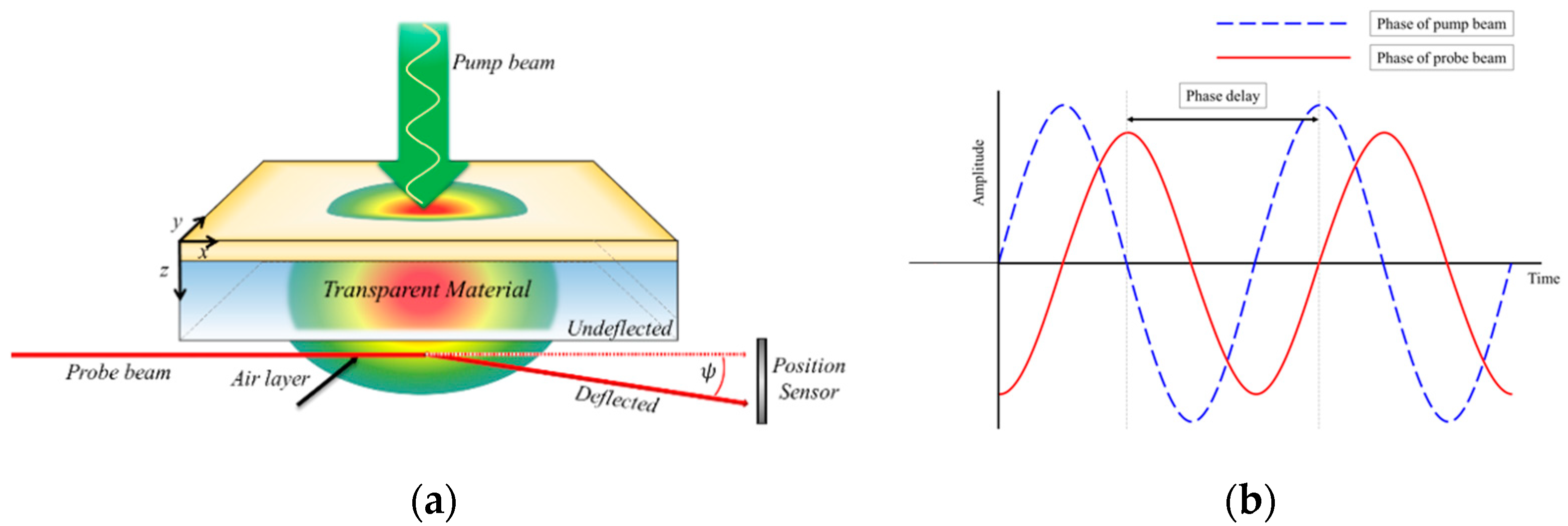


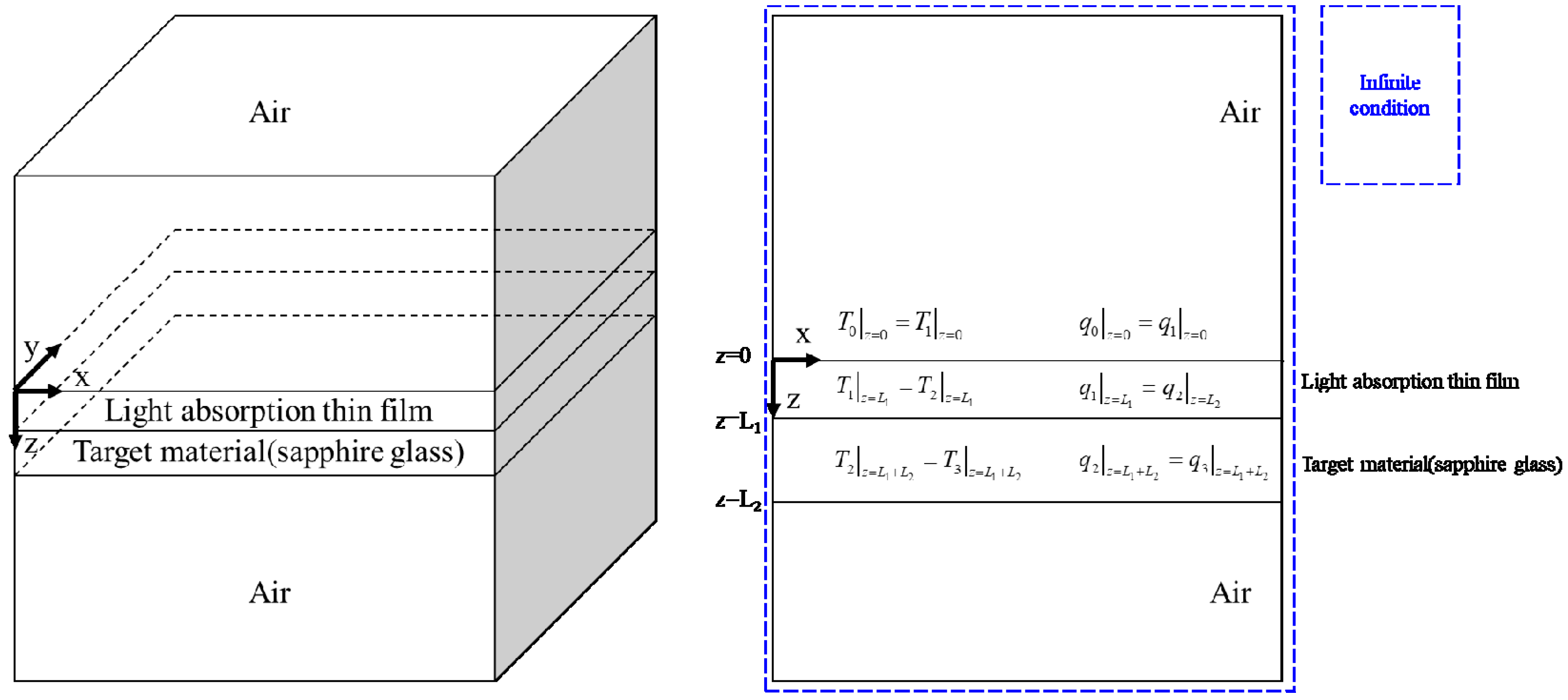
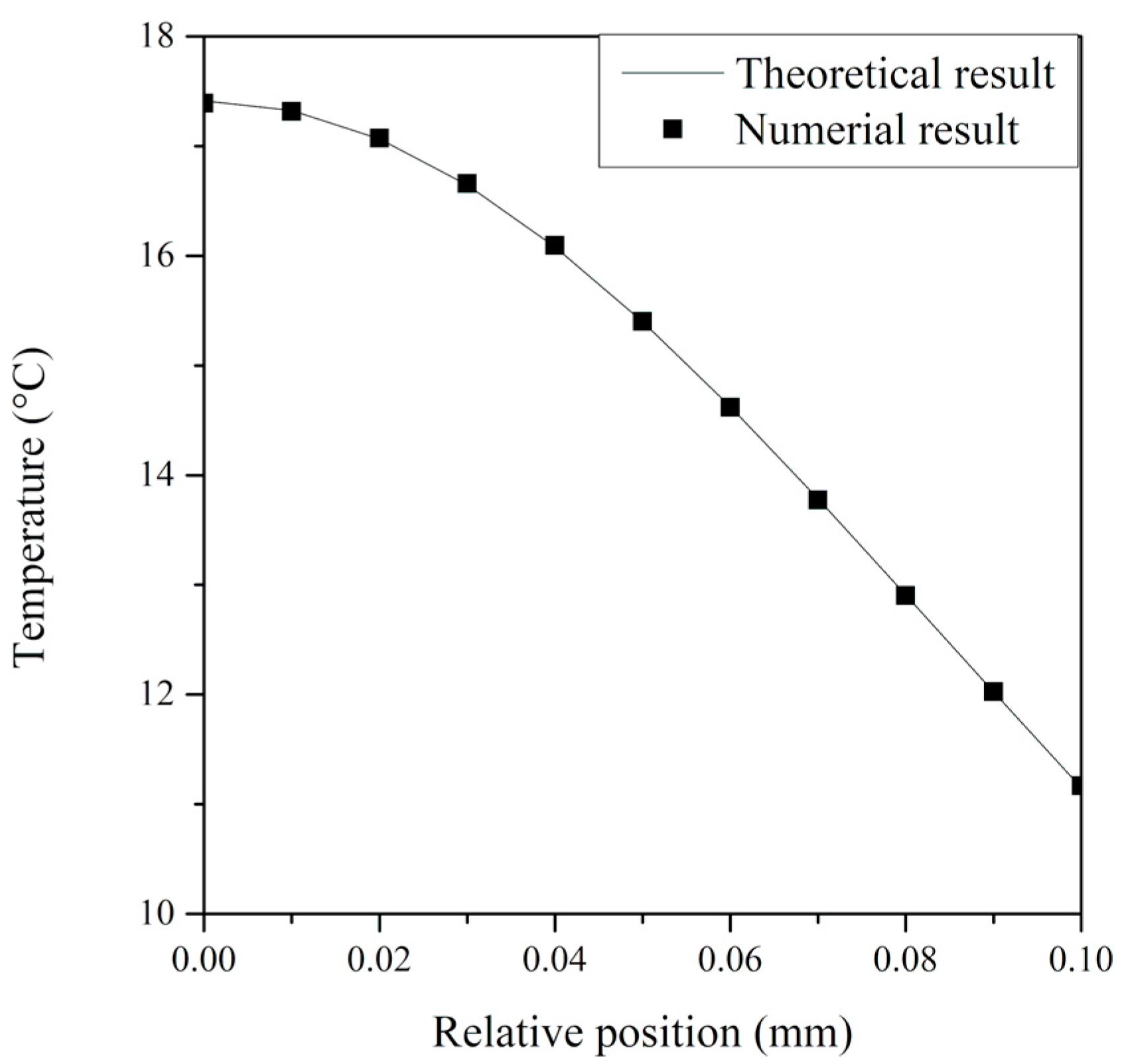
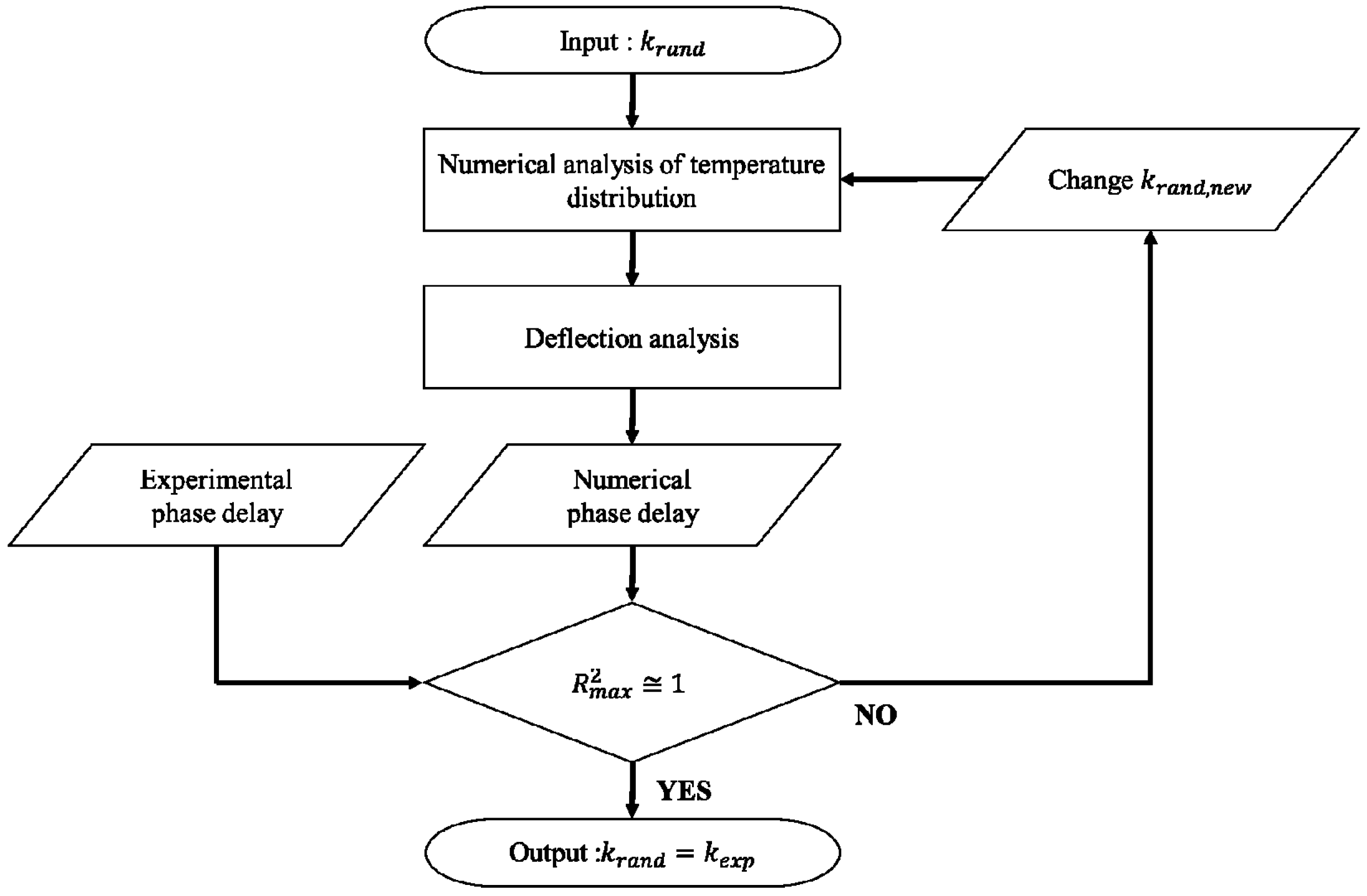

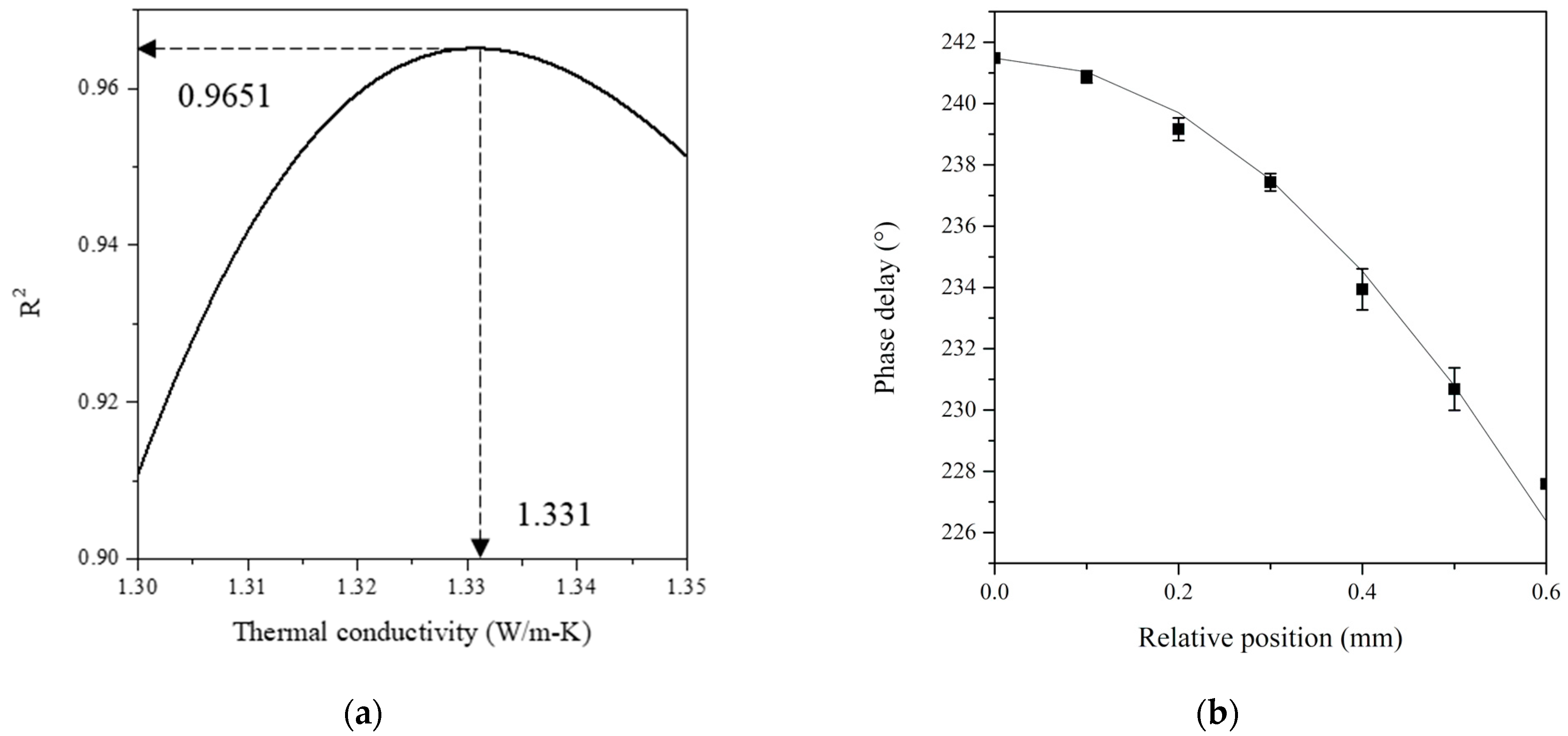
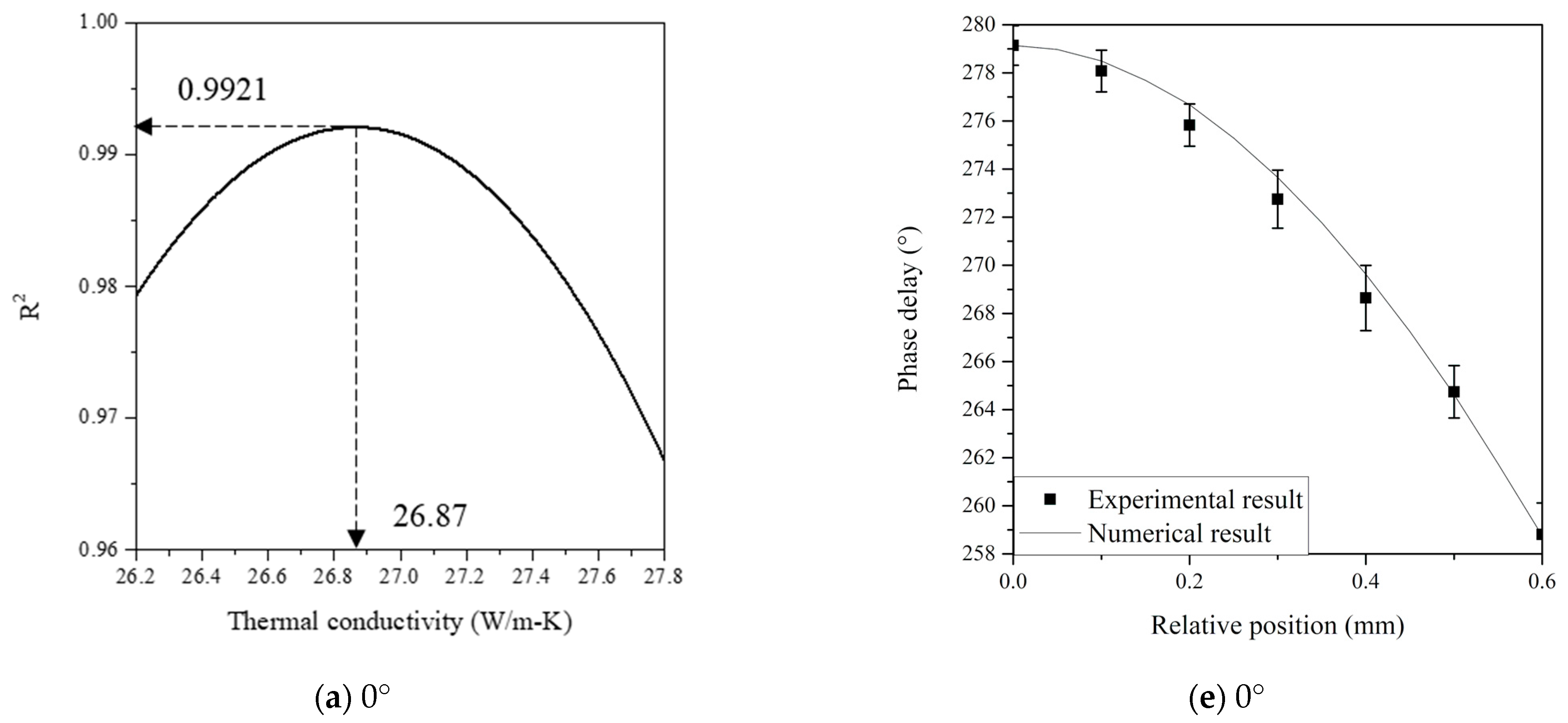
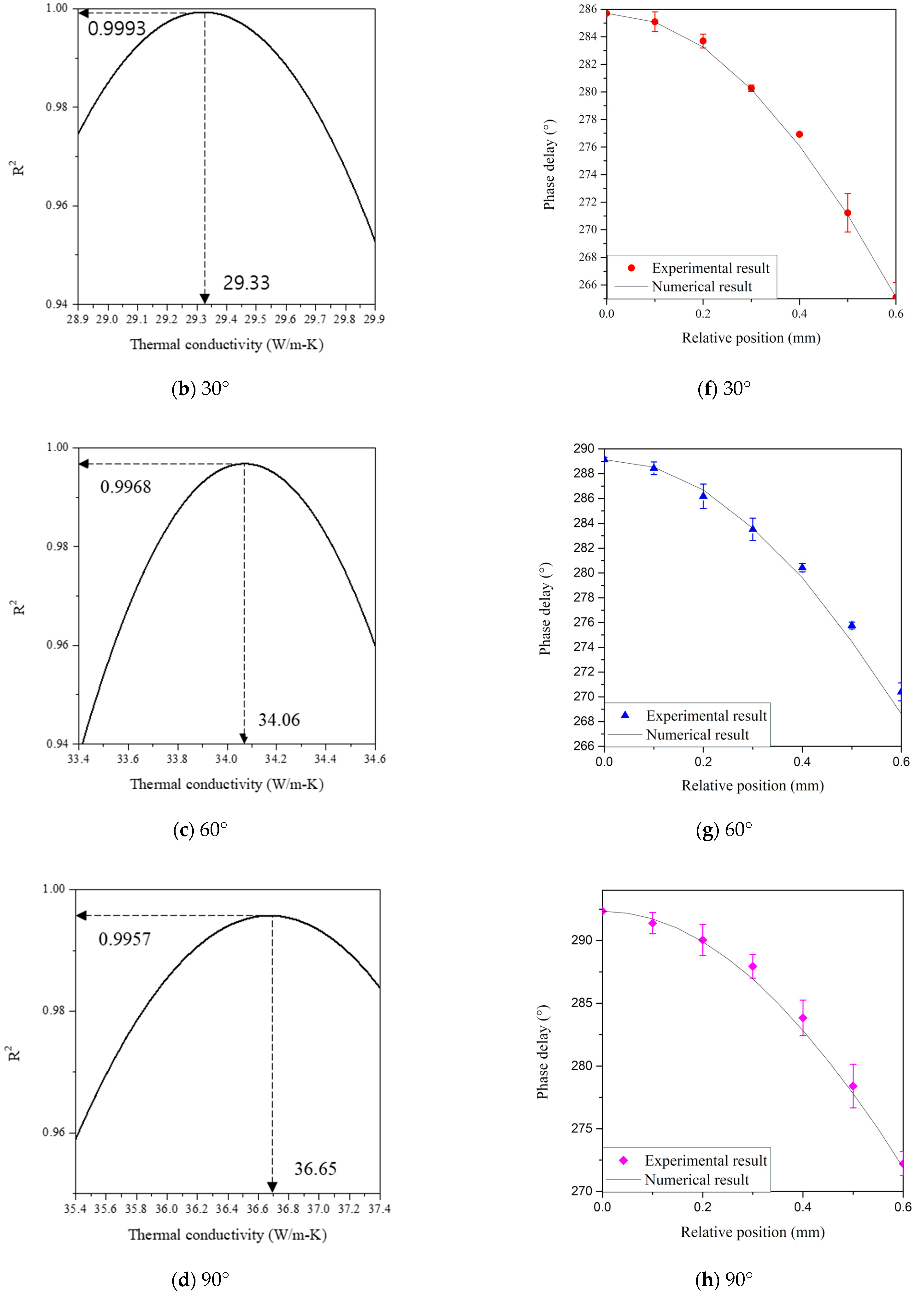

| Method | Limitation | |
|---|---|---|
| Contact | DC heating [5,6,7] | Conductive materials only |
| Pulse heating [8,9,10] | Conductive materials only | |
| Laser calorimetry [11] | Large amount of heat loss | |
| 3ω Method [12] | Complexity damage of specimen | |
| Non-Contact | Photo Acoustic [11] | Low accuracy |
| Laser Flash [13,14] | Damage of specimen and limitation of shape/size | |
| Photothermal radiometry [11] | Problem of emissivity factor | |
| Photothermal reflection [11] | Standardization of roughness on surface of specimen | |
| Photothermal displacement [11] | Surface treatment of specimen | |
| Photothermal deflection [11] | Increase of S/N |
| Number of Mesh | Phase Delay (°) |
|---|---|
| 125,375 | 145.6057 |
| 784,036 | 147.5570 |
| 1,434,175 | 148.1252 |
| 2,873,162 | 148.0972 |
| 4,000,894 | 147.5738 |
| 6,254,729 | 147.5345 |
| 7,345,315 | 147.5596 |
| 8,732,682 | 147.5505 |
| Copper [34] | Air [35] | |
|---|---|---|
| Density(kg/m3) | 8930 | 1.161 |
| Specific Heat(J/kg-K) | 385 | 1007 |
| Thermal Conductivity(W/m-K) | 385 | 0.0263 |
| Material | Rate (Mass%) |
|---|---|
| Cu | 99.9461 |
| S | 0.0223 |
| P | 0.0316 |
| Thermal Conductivity (W/m-K) | Specific Heat (J/kg-°C) | Density (kg/m3) | ||
|---|---|---|---|---|
| Quartz | 1.4 | 710 | 2650 | |
| Sapphire glass | 36.1 | 761 | 3980 | |
| 27.1 | ||||
| 36.1 | ||||
| Condition | Value |
|---|---|
| Intensity of pump beam (W) | 1 |
| Radius of pump beam (μm) | 75 |
| Distance to probe beam from rear side surface (μm) | 150 |
| Relative position (mm) | 0 to 0.6 (interval 0.1) |
| Modulated frequency (Hz) | 20 |
| Thermal Conductivity Reference Value (W/m-K) | Thermal Conductivity Experimental Value (W/m-K) | Absolute Error (W/m-K) | Relative Error (%) | |
|---|---|---|---|---|
| Quartz | 1.4 | 1.331 | 0.069 | 5 |
| Crystal Orientation (°) | Thermal Conductivity Reference Value (W/m-K) | Thermal Conductivity Experimental Value (W/m-K) | Absolute Error (W/m-K) | Relative Error (%) |
|---|---|---|---|---|
| 0 | 27.10 | 26.87 | 0.23 | 0.8 |
| 30 | 29.40 | 29.33 | 0.07 | 0.2 |
| 60 | 33.85 | 34.06 | 0.21 | 0.6 |
| 90 | 36.10 | 36.65 | 0.55 | 1.5 |
Publisher’s Note: MDPI stays neutral with regard to jurisdictional claims in published maps and institutional affiliations. |
© 2021 by the authors. Licensee MDPI, Basel, Switzerland. This article is an open access article distributed under the terms and conditions of the Creative Commons Attribution (CC BY) license (http://creativecommons.org/licenses/by/4.0/).
Share and Cite
Kim, G.; Kim, D.; Kang, S.; Yoo, J.; Kim, H. Research on Measuring Thermal Conductivity of Quartz and Sapphire Glass Using Rear-Side Photothermal Deflection Method. Appl. Sci. 2021, 11, 1535. https://doi.org/10.3390/app11041535
Kim G, Kim D, Kang S, Yoo J, Kim H. Research on Measuring Thermal Conductivity of Quartz and Sapphire Glass Using Rear-Side Photothermal Deflection Method. Applied Sciences. 2021; 11(4):1535. https://doi.org/10.3390/app11041535
Chicago/Turabian StyleKim, Gwantaek, Donghyuk Kim, Sukkyung Kang, Jaisuk Yoo, and Hyunjung Kim. 2021. "Research on Measuring Thermal Conductivity of Quartz and Sapphire Glass Using Rear-Side Photothermal Deflection Method" Applied Sciences 11, no. 4: 1535. https://doi.org/10.3390/app11041535
APA StyleKim, G., Kim, D., Kang, S., Yoo, J., & Kim, H. (2021). Research on Measuring Thermal Conductivity of Quartz and Sapphire Glass Using Rear-Side Photothermal Deflection Method. Applied Sciences, 11(4), 1535. https://doi.org/10.3390/app11041535






